Text
Baby, We’re Coming Home
On our to-do list in Malawi are two more things.
One: making the journey to Likoma Island, which is exactly what it sounds like - a large, little-inhabited remote island on the far side of Lake Malawi. It’s so much on the “far side”, in fact, that it’s basically grazing the coast of Mozambique, but is still considered Malawian territory. There are various boats making the journey to and from Likoma Island daily, most of which leave from Nkhata Bay, just 100 kms or so north of our last camping site at Kande Beach. But this being Malawi, there aren’t up-to-date schedules for these vessels you can consult online - their times and even dates of arrival can vary depending on the weather, mechanical issues, etc. You can get a general idea of the “usual” schedules from online research, but mostly you have to show up at the port and ask when the next boat is leaving.
Which is exactly what we did! The biggest and most comfortable vessel making stops at Likoma is the Ilala - a massive ferry that continuously makes loops up and down the length of Lake Malawi. We arrive in Nkhata Bay to discover that the Ilala left the day before (wahhh); the next boat going to Likoma is the Lamani - a small, privately-run boat. Tickets are only USD 3.50 - what a steal. The port workers inform us we have to be ready to board by 830 am the following morning.
We wake up early and make arrangements to leave our car for a few days at a local backpackers in Nkhata Bay, then walk into the village to buy a few snacks for the journey. Popular in Malawi are fried bread buns cut open in the middle and slathered with butter, appropriately called “McDonalds”. We buy a few buns, a bag of chips, a bottle of Malawi gin, and a box of wine for the sea road. Arriving at the boat, the jetty is packed with people loading supplies onto the Lamani: crates upon crates of beer, massive bags of cheese puffs, huge bundles of wheat.

One woman appears to be bringing an entire kitchen sink installation on board, leading Matt to crack the joke that the boat’s cargo contained “everything but the kitchen sink! ....oh wait...”

We jostle ourselves a spot on a narrow bench near the front of the boat, and wait. Aaaand wait. The stacks of cargo to be loaded finally dwindles an hour later, and the boat pulls out of the jetty at about 945 am. What we assumed to be a slow-and-steady starting speed turns out to be its top speed. We settle in for a long journey.
The benches are uncomfortable. The lake is rough. Most people have spread out blankets on the ground and are taking naps, pillowed by our cargo. We pass through a cloud of lake flies, littering our laps with tiny flapping bugs. The island is not in sight.

We ultimately find out we are making two stops to unload cargo on another island before making it to our final destination at Likoma. It takes all day. We finally roll into the Likoma beach after dark, at about 7 pm.

Likoma Island doesn’t have a proper jetty, so the boat anchors just offshore and many rowboats hurry out to unload the remaining people and crates. We negotiate a lift in to shore - 20-second ride on one of the rowboats - for about USD 0.25 each. And finally, 11 hours after we began, we are standing barefoot on the dark beach, feet wet and jeans rolled up to our knees, holding our box of clothes and a box of wine, on Likoma Island.
We’re met by a guy working for the backpackers where we’re staying - Mango Drift - and go with him on a bumpy ride in the back of an off-duty ambulance (sharing our sitting space with a spare tire) - to the other side of the island. Due probably to the difficulty of getting there, accommodation on Likoma is quite cheap: we’ve scored our own private beach chalet at Mango Drift for USD 30 per night! The place is warm and welcoming. We’re the only guests, making it TRULY our own private beach. We’re greeted by hot plates of vegetable curry and a tiny puppy named Rafiki.

Welcome to paradise.

The next day we go for a little walk around the island. We pass through a fishing village and are instant celebrities with a crowd of local kids. They insist on holding our hands and walking with us, chattering to each other in Chichewa and demanding sweets and money from us in English the whole way.

We have a beer at the island’s only bar, Beach Breeze, and a VERY cheap fish lunch. Not pictured: Matt ordered “the chicken” for lunch and is served with ONE SINGLE CHICKEN WING in a tiny bowl with sauce. Luckily I had plenty of nsima (maize meal mixed with water) to share....


Hiking back to Mango Drift, we take afternoon naps in the beach hammocks. Play a bit of pool with gin and tonics. We have a candlelit dinner at a table set up for us on the beach, and later watch the lunar eclipse rise over the island.
The following morning, though, we have a difficult decision to make. We’ve been informed that there’s one boat coming back to Nkhata Bay that day (Saturday) - but the next boat isn’t until...WEDNESDAY. We can either leave, after one glorious day in paradise - or stay for six more days.
Now, this may seem like an obvious choice. You stay, right??!!
But we were growing steadily more homesick and basically, six more days in paradise (when we’d already had months on the road with plenty of beach time) meant six fewer days in the warm embrace of home, family, and friends.
It might have been the wrong choice. We’re still not sure. But we packed up and left that morning.
The boat going back to Nkhata Bay is a different one - the Chilembwe. It’s a bit bigger and a bit faster (our journey only takes 5 hours this time) but is 5 times more crowded.

We luckily score a spot sitting on a narrow ledge overlooking the cargo area. We can dangle our feet, feel the breeze on our faces, and are protected from other people bumping and crowding us - we are happy.

We feel almost energised arriving back - quite an achievement for a 5-hour boat ride!
We spend the next day lazing around reading books next to the water.


The restaurant across the bay is having an all-day pizza special, so we kayak across and stuff our faces with pizza and margaritas. The kayak ride back was MUCH MORE wobbly, needless to say...
But we were getting properly excited for our last big activity, our last thing on the to-do list: a night dive in Lake Malawi.
It’ll be quite different from diving in Mozambique - you’re less buoyant in freshwater, for one thing, but the depths are much shallower and there’s less life to look at/be terrified of in the total darkness.
As the last rays of sunlight vanish behind the hills, we back-roll off the boat and sink into the deep, guided only by our divemaster Zoe and our flashlights. Night diving in Nkhata Bay is a special experience, in that we are assisting a nocturnal hunt. Dolphinfish - grey, nearly-blind fish 2-3 feet long - use the light of our torches to find and eat cichlids (the many tropical fish found in the lake). As soon as we reach the bottom of the lake, a pack of a dozen or so dolphinfish arrive, following our beams of light around the rocks for the rest of the dive. This area is also populated by sizeable catfish and many crabs - we see no end of catfish whiskers cruising and crabby legs scuttling amongst the shadowy rock formations.
At the end of the dive, we rise to the surface and kick on our backs to the waiting boat, marvelling for the last time at the galaxy twinkling high above, it strikes us - our trip has come to an end......
It takes a few days for us to make the drive back to Lilongwe and get our things in order. We make one last camping stop in Ntchisi, a rain forest reserve just north of the capital. We finish off our boxed wine and cackle late into the night making lists of highs and lows, bests and worsts, memorable moments and honourable mentions.
We’re leaving the car in Lilongwe for our friend to come pick up and do a road trip of his own back to Cape Town. We get it washed and cleaned; we pick up some gin and chitenge as gifts for our friends back home; and before you know it we’re in a taxi on our way to the airport to catch a 3 am flight back to Cape Town (via a 9.5 hour layover in Nairobi.....)
We can’t wait to be back.
0 notes
Text
Journey to the Lake of Stars
Last stop: Malawi. One of Matt's ex-coworkers has a sister, Marcia, living in the capital Lilongwe who very generously offered us to stay in her spare room. From South Luangwa we head southeast, passing through the sprawling transit town of Chipata then on to the border at Mchinji. There are lots of guys hanging around the city offering to change money between Zambian and Malawian kwacha, and Stoffel is a magnet for these types. Just trying to fill up with petrol, we were surrounded by four guys telling us they'd been "sent from the border" to "help everyone" by changing money. Very altruistic of them, right??
As usual, crossing the border is an exercise in patience and avoiding direct eye contact with the guys trying to extract money from you. This border was notable for its insanely antiquated way of accepting payment: receipts have to be written out in triplicate using loose strips of carbon paper, placed into a bag, and funnelled through a narrow slot into a back room. Of course, none of this is explained to you or marked on any signs - you're just handed a stack of carbon paper and expected to take it away!
Lilongwe is small for a capital city, but green and beautiful. Marcia lives in a walled compound in Area 12, a wealthier district where a lot of diplomats and ambassadors also live. After Marcia welcomes us in, we sit down outside for a glass of wine - and that's when people start rolling in. First Marcia's housemate stops by. Then her cousin. Then three other friends. Within an hour we're invited to a dinner party at the house of one of Marcia's German friends. And also, a hike up a mountain the following day. This is the start of a noticeable trend: Marcia's house is a bustling hive of people coming and going, hanging out, dropping things off, popping by for a cigarette, taking off again. We meet more people in Lilongwe than we have on the rest of the trip combined! But after weeks of being on the road and missing our social life in Cape Town, we're not complaining.
We do go to the house party, then to a club afterwards, staying out juuust long enough to ensure that we'll be properly hungover for our hike the next day.
The mountain, though, is stunning. Nkhoma Mountain is positioned 30 kms outside Lilongwe - a high peak rising from flat plains, giving us a gorgeous panoramic view of Malawi stretching out beneath us on all sides.

The next few days are a blur of social activity. There are more braais at Marcia's house; we go out clubbing; we venture to a nearby beer garden to watch the World Cup final. Some of our new German friends accompany us to the local market to go shopping for chitenge - colourful cloth worn across central and eastern Africa. There are lots of tailors working in Lilongwe, so Matty and I stock up on chitenge and order ourselves some custom-made shirts, shorts, dresses, jackets, and skirts. Did we go overboard....? No. No, definitely not.

After 4 days in Lilongwe, we're ready to hit the road again. We drive south, aiming for Mount Mulanje: the highest mountain in south-central Africa. Unfortunately, the weather starts turning south too, and the whole of southern Malawi is covered in rain pouring down from thick, low-hanging clouds. We arrive at Chembe Eagle's Nest, a hiker's lodge at the base of Mount Mulanje after dark and in the rain, having driven 20 kms off the main road down a slippery dirt track covered in deep, sticky mud. We splurge on renting a room for the night - as camping out in the rain and mud doesn't look too appealing - make ourselves PB+J sandwiches, and huddle inside for a movie night.
The next morning, the rain continues and the clouds haven't budged. Despite sitting at the base of one of the tallest mountains in Africa, we can't see a damn thing above the level of the treetops. We call Mulanje quits and drive instead through more mud, cold and rain to nearby Thyolo, a tea-producing region.

It's the perfect weather to huddle next to a fire with pots of locally-grown black tea and coffee and chocolate cake....so that's exactly what we do at Huntingdon House, a tea estate. For about 3 hours.
As the afternoon wears on we've got to get on the road again - we're staying the night 150 kms north of Thyolo on top of the Zomba Plateau. There aren't many campsites on top of the plateau but I've found a very cheap (USD 17 for both of us) self-catering cottage located at a trout farm there. Why are they producing trout on top of a plateau? I don't know. Stop asking silly questions.
We've stayed so late at Huntington House that we are approaching our accommodation after dark (again). It's still raining, and as we've ascended up the plateau we find the top still shrouded in mist. The road is narrow, muddy, and windy - we're faced with navigating to the trout farm with imprecise directions (my fault) while not driving the car into the lake next door.
Happily, we make it to the trout farm without killing ourselves or anyone else. "Self-catering" sounds a bit grand for what the cottage actually is: it has two bedrooms and a fireplace, true, but there's no running water or electricity. Luckily we're as kitted out as anyone could possibly be for this kind of situation, so we haul our boxes of food, gas canisters, and firewood inside to cook a pasta supper in the living room by the light of our head torches.
We spend the following day tooling around the plateau. A local named Boneface offers to guide us on a hike in exchange for USD 7. (This is a sentence I never expected to write in my life). Turns out we didn't need a guide (there is a straight road directly to the viewpoints) and we couldn't see anything anyway (the plateau is still shrouded in mist), but it was a nice walk. Zomba Plateau's main industry is lumber, and we were treated to many views of shirtless men sawing away at giant tree trunks.
From Zomba we head to the tranquil shores of Lake Malawi: Cape Maclear! It is a tiny town inside Lake Malawi National Park, a UNESCO heritage site. It's yet another beautiful beachy paradise.


Lake Malawi is full of colourful tropical fish called cichlids, and we go scuba diving at a site called the Aquarium to swim through thousands of these fish in frolicking in the clear lake waters. We kayak a bit around the lake shore and have a fish lunch at the only locally-owned restaurant in Cape Maclear, Banapaya.

After two days hanging around Cape Maclear, we drive north along the lake shore. It's surprising how little development there is around the lake - while it is a vital food source for many Malawians, there's next to nothing in terms of tourist infrastructure or even small towns. Much of the lakeside is dotted with tiny villages. The one exception turns out to be the place we stay for the night: Kande Beach, a lovely stretch of sand that we end up sharing with 3 overland trucks packed full of 30 rowdy tourists. They're doing a fancy dress night, and most of them are dressed in sequins and/or leopard print while playing drinking Jenga and blasting "Despacito". It wasn't our favourite campsite.
Our time in Malawi is running short and there are two things left that we really want to do....
0 notes
Text
A Change in Plan

One thing we've realised on this trip is - Africa's really not as wild as you think it is. At least - southeastern Africa is pretty well-developed in terms of infrastructure and catering for tourists. Almost all the campsites we've stayed at are equipped with showers, flush toilets, and electric plug points to charge your fridge/drone/phones/whatnot. Many have WiFi, bars and restaurants, and some even have pools. This is, simultaneously, *AWESOME* and yet...disillusioning, in some ways. You pack for every eventuality, thinking that hey, this is Africa, we're inevitably going to end up in some survivalist situation where you're stuck somewhere for three days, your supplies are down to warm beers and plain rice, and you only manage to get your car out using a tow rope fashioned from your sleeping bags attached to a passing donkey cart.
Simultaneously though, we are planners. Call me crazy, but I like to know where I'm going to sleep tonight. We've not ever made concrete plans more than a few days in advance, but we're not experienced 4x4-ers or car mechanics. We haven't sought out the most extreme routes or isolated places. It's just the two of us, we're not traveling in convoy, and we wouldn't have much in the way of support if we sought out the wildests of wild and ended up with a breakdown or accident.
So we've played it relatively safe, and here's how it's ended up working: you google "campsite in Lower Zambezi". Find a place with a website and a few photos. It looks nice, so maybe you send an email letting them know you'll come by tonight, or maybe you just show up there. Stay the night or three. Camp for cheap, generally about USD 20 a night for both of us, but take a dip in the pool, use the Wifi, maybe have a meal in the restaurant when you're running low on supplies. Have a gin and tonic at the bar when you run out of ice in the car fridge, and next thing you know, you've come several months through your adventure through Africa having never been in want of... anything, really. It's been fun, and comfortable, but surprising: the revelation that self-driving southeastern Africa = camping deluxe.
This trend over time to us was especially apparent in Zambia. After Vic Falls - a highly developed tourist area with coffee shops and fancy grocery stores galore - we set off to Lower Zambezi. One easy day of driving took us to Kiambi, a beautiful campsite just outside the national park, sat directly on the banks of the Zambezi River. Here we spent two days and three (glorious) nights - wallowing in the pool in the afternoon with some white wine, jamming some music on our portable speaker. Watching the sunset. Braaing around the fire and marvelling at the carpet of stars laid out before us at night.
From here we drove northwest. We aimed for Chipata - a transit town close to the border of Malawi - but underestimated our drive time and ended up camping in the parking lot of Thabo Lodge, a traveller's lodge on the side of the one-lane highway. Plain pasta and chips in the restaurant, where we watched an Australian cooking show on the TV perched high on the wall and observed a cockroach making its way across the lobby floor. This was definitely the closest we came to roughing it in Zambia.
The next day we arrived at Wildlife Camp - again, a gorgeous camp situated on the banks of a river (South Luangwa, this time) with a bar and plunge pool.


This one was rather infested by baboons: anticipating some extensive gin-and-tonic time by the river, we had bought some lemons, but they were stolen off the table by an enterprising ape while we were still unloading the car, not ten minutes after our arrival.

The camp was also inhabited by a roaming band of banded mongooses (Matt’s favourite animal).

One of the bartenders showed us a sound the camp uses to call them when it’s feeding time. Matt later sneakily tested this out, resulting in a riot of tiny mongooses around our car, angrily blinking that we didn’t *really* have any food for them.


We made a series of small local trips in our days at Wildlife Camp. One afternoon jaunt was to the Mulberry Mongoose, a community jewelry-making enterprise. They work, in part, with anti-poaching units to collect snare wire, which they then use in jewelry and donate part of their proceeds to conservation efforts. I came away with a pair of earrings.
The World Cup was still on, with a semifinal game between England and Croatia taking place our second night at the camp. WildLife Camp did have WiFi, which they ostensibly offered between the hours of 12 and 2 pm, but no TV. However we got a hot tip from one of the camp staff that the Wifi would still be on that night, so we set up our laptop outside the front office - where the Wifi's short reception reached - to watch the game. Before the end of the night we had about 12 people crowded around that laptop in the darkness, all (well mostly) cheering on Croatia to win the game.
We also took one sunset/night drive into neighboring South Luangwa National Park.



The area is known for having flashy leopards - that is, lots of leopard sightings - and our drive did not disappoint. We saw two: one inside the park, hustling into some bushes, and one on our drive back home just outside our camp, crossing the road. We just about drove right past it and our driver, in his excitement of pursuit, reversed our car over a signpost marking the way back to camp. We made a pit stop after the leopard ran off to bend the sign back into shape.





At USD 75 per person though, the drive wasn't cheap. And it was at this point on our trip, camped on the banks of the South Luangwa, that we started to seriously reassess the journey and money spent so far. To be fair the first part was easy - we'd had an amazing time. Didn't regret a minute.
The second part was more difficult. We'd been working to a budget of USD 100 per day, and this was supposed to be all-inclusive: all our visa fees, petrol, food, activities, the lot. But despite our best efforts, and being SUPER budget on as many things as we could (should we spring for this extra USD 5 bundle of wood, or go without a fire tonight?) we weren't hitting it. Apart from splurging on all our diving in Mozambique (whoops), this is mainly due to petrol. Stoffel, as powerful a car as it is, chows petrol like no one's business. Even taking our sweet time in terms of distance covered per day, we were spending USD 200-300 every 3-4 days or so on petrol alone. And this on mostly tar roads; our fuel consumption is cut in half on sandy tracks, potholes, or poor dirt roads. This combined with the staggeringly high (by SA standards) cost of living and conservation fees in Zimbabwe and Zambia was putting a serious dent in the budget.
Tanzania was also looming large in our minds. The country is massive and most of the roads aren't great (equalling lots of money on petrol). Most of what we wanted to do there was vising national parks like Ruaha and the Serengeti to see the Great Migration (equalling lots of money on conservation fees. For perspective, to self-drive into the Serengeti and camp in a clearing with zero facilities costs about USD 150 per day in conservation fees alone - not inclusive of petrol, food, drinks, or any guided game drives. Due to the size of the park, we'd want to spend at least 3-4 days inside, making it quite a pricey few days even while doing it the absolute cheapest way possible). We had planned to finish off the trip in Zanzibar: maybe doing a few dives, staying on the beach....but Zanzibar isn't exactly known for being a budget paradise. And we were really starting to miss our friends and family in Cape Town.
I'm droning on, but the point is the trip was starting to reach the point of diminishing returns. We've had plenty of time lazing on beaches, in pools, in the bush. Exploring cities, chilling at backpackers, meeting new friends. But we still need to arrive in New York at the start of September, and we were starting to think we'd value spending more time with our loved ones in Cape Town before emigrating than another few weeks camping, being as budget as possible, in a high-end tourist market.
So...we decided to cut the trip short. Rather than ending in Dar Es Salaam, we're spending a bit of extra time exploring Malawi and ending the trip in Lilongwe, the country's capital. This means we're heading back to Cape Town in the first week of August - giving us three full weeks to explore Malawi to its fullest, STAHP caring about the budget, and end on a high note.

1 note
·
View note
Text
Badgers, warthogs and waterfalls
After our first night in Mana Pools National Park, we woke in Nyamepi Camp to grass trodden down by elephants and hippos. Both use the camp as a convenient through-road to the Zambezi. Along with monitor lizards.



We treated ourselves to an idle sunrise with coffee over the river.

The Zambezi was quickly becoming the defining landmark of this part of the trip, like Table Mountain back home. We spent the morning travelling further along its bank, watching hippos and crocs from the safety of an elevated shore.

On returning to camp for lunch, we discovered the gruesome remains of our tent. Its flank had been sliced open with surgical precision, spilling out its organic insides. Sugar, spice and everything nice were strewn, half-eaten, guiltily in a trail from the opening. Potatoes, sweet and otherwise, lay scattered, each with a single bite taken. The Cremora, which was stored inside, not on top, coloured the dirt in white powdery patches, as if our camp was an Escobar cookhouse after a hit.
It was not guerrillas, but baboons. We had foolishly forgotten to seal our dry goods container inside the tent. We took stock of the damage and recomposed ourselves with a riverside beer. A troop of Vervet Monkeys quickly interrupted. Emboldened by the baboon’s success, they made for the remains of the food, only to be fended off by two grumpy beer-wielding humans.
We struck up a neighbourly relationship with our neighbouring campsite: the anti-poaching unit. When we first arrived at our designated camping spot, we found a small tent off to the side, complete with two pairs of flip flops, a gas canister and jerry-rigged trip wire. The tent lay abandoned for the first day, causing us to wonder if the occupants had either deserted it, or perhaps had experienced first-hand the crushing power of a hippo jaw. Late into the night, they returned, a British couple. One half was a bearded, conservative and carnivorous ex-military man who was now managing a team of local armed rangers. The other half was a soft-hearted and outgoing vegetarian woman, championing the community relationship element of anti-poaching. We joined the couple of opposites for after-dinner drinks, gin and tonics and whisky. We drank late into the night, on the shore of the Zambezi, protected by a make-shift trip wire, as hyena circled our fire.
The next morning, we moved on from the riverside Nyamepi to Chitake, an inland campsite by a fresh water spring. Chitake is reputed to be one of the wildest camping spots around. It sits squarely in the territory of a pride of lions, and consists of 3 small clearings, and nothing else. No staff, no buildings, no fences, nothing for kilometres. Even the rangers say that you need to keep your wits about you at Chitake, and they would usually bring a gun.



Our spot, Chitake 2, was the most remote of the clearings, and we had no gun. We were armed only with raw meat, the potential for fire, Kristen’s reckless bravery and Matt’s half-swallowed caution.


After a few beers by the spring, we sat around a large fire and a curry potjie, listening to the roaring of the lion pride at an indeterminate distance. Half-way through our meal, a silhouette casually stumbled into our campsite. It was quickly lit up by our headtorches in unison, revealing our trip’s spirit animal: A honey badger. It stops, looks at us briefly, performs an elegant 180 degree spin and shuffles off at the same speed it entered. It met up with its partner and the two trundled off into the night, presumably to maul the lion pride, just for kicks.
Mana Pools was one the most unforgettable and majestic experiences, despite being the priciest expensive small patch of dirt (around 100USD for a night at the deserted clearing).



Still riding on a spare wheel, and with a newly noticed oil leak, we continued on our journey to Kariba, the town on the Zimbabwean side of the Kariba Dam, where we could hopefully get the tyre and oil leak fixed.
At Kariba, we stayed at Warthog Camp, right on the edge of Lake Kariba, which was far and away the best value accommodation of our trip thus far. 5USD per person per night, for a camping spot, warm showers, WiFi and complementary (but not complimentary) elephant room service. At this point, we were used to efalumps strolling through our camp. These ones were different though. It was sizable herd, a dozen or so including baba efalumps.


Perhaps this is why the large male took severe exception to our presence. He proceeded to mock charge us, rearrange our cooking equipment (he thought it looked better on the ground rather than the table), chased us around the car, had a drawn out fight with a rubbish bin and finally decided to destroy a tent set up next to our car. The video below caught some of it.
youtube
We spent 3 nights at Warthogs, watching the hippos frolic, dipping into the pool, enjoying a beer and a braai and plotting our next course. We also took a sunset cruise in a catamaran out to Antelope Island in the middle of the Lake, drinking our Zambezi beers while hearing a brief history of Kariba.



Construction of the dam was started in the 50s, commissioned by what was then Northern and Southern Rhodesia and Nyasaland. Italians were brought in to build the dam, and the town of Kariba was developed around these workers. 86 of them lost their lives through accidents during construction, including a few who fell into wet concrete. Their bodies could not be retrieved and are still set within the dam wall to this day.
The valley around the Zambezi before the Kariba Gorge, what is now Lake Kariba, was not deserted. Tonga people lived around the river, and had done for generations. They were tied to the river, protected by Nyami Nyami, the Zambezi River God, who they believed lived in the Kariba Gorge. In 1955, the Tonga people were forcibly removed from their homeland, which would be flooded by the creation of the dam. In addition to understandably not being happy being relocated, the Tonga believed that the dam would greatly anger Nyami Nyami, who there. It would also stop him from swimming up and down the Zambezi and split him from his wife who lived elsewhere. Sure enough, for two seasons in the early construction of the dam, the Zambezi was hit by the two worst floods in generations, severely damaging the partially constructed dam. The Tonga believe it was the angry River God fighting against the dam. Nevertheless, construction continued and many displaced Tonga people feel that they have been forced to live as semi-refugees in their own land, that they have not benefited from the creation of the dam and its power, and the town and its tourism. Many still believe Nyami Nyami will destroy the dam, allowing them to return home.
We took heed of this warning, along with rumours that the bedrock beneath the dam has eroded leaving it in a very dangerous state, as we drove along the dam wall to cross the border into Zambia. While this was the most scenic border crossing and surprisingly quiet, our entry on the Zambian side shocked us with hidden costs. We waived the 50USD temporary import permit for our car, because we have a Carnet De Passages. This left us with $80 for Kristen’s visa, $40 for “Carbon Emission Tax”, $30 for a “Road Access Fee”, $30 for “Council Fee” and, of course, $40 for third-party insurance. The Road Access Fee was especially frustrating as our first day in Zambia saw us taking the road to Livingstone: the road trucks take between Lusaka, the capital, and Livingstone, the tourist capital. This was probably the worst tar road either of us has ever driven, and had us dodging potholes, pot valleys, a few overturned trucks and goats galore. What we estimated to be a 7-8 hour journey turned into 10 hours, including the challenge of drawing money and finding a petrol station that actually has petrol.

Although rural Zambia is quite underdeveloped, the urban areas are rapidly growing. After our time camping in the wild, entering Livingstone felt like tourist-central. The whole city was geared towards Victoria Falls. We found our way to The Waterfront, a rather fancy riverside resort. Along the way, we noticed a large Chinese contingent to the city, so we decided to take a break from our standard braai meat fare to swing by “The Lucky Dragon” for supper. We celebrated the end of a long day and treacherous drive with surprisingly delicious chicken sweet sour and spicy pork.
Victoria Falls exists where the Zambezi has cut its way deep into the earth, Nyami Nyami’s route to the underworld. The Victoria bridge links Zambia and Zimbabwe which share the river and falls between them, with Livingstone on the Zambian side and the town of Victoria Falls on the Zimbabwean.
Victoria Falls is called Mosi-oa-Tunya in Tonga, roughly translated as the smoke that thunders. It’s an apt name. It was all glory and power, making a mockery of the other trickles and drips that have the gumption to call themselves waterfalls.

We walked across the Victoria bridge through a border post to look at the falls from the Zimbabwean side. The falls themselves were shrouded in mist. Every moment or so this mist would part to reveal the mighty waters behind. Soon we were both soaked through, despite raincoats and ponchos.


We squelched our way to a nearby 5-star hotel to warm up with a pot of coffee and the opportunity to revel in the glory we had witnessed.


We spent a few days in Livingstone, restocking our supplies and finally getting Stoffel’s oil seal replaced, before leaving back along the road of death to our next destination: Kiambi Camp, right outside of Lower Zambezi National Park.
0 notes
Text
Easy on the Zambezi
Crossing the border into Zimbabwe - like the majority of our crossings, a remarkable and chaotic experience. We've chosen the Mutare/Forbes post which, compared to the Beitbridge post between Zim and SA, is by far not the busiest crossing. Still: overwhelming. On the Mozambique side, 3-4 guys come close up to the car as we park, just about pressing their faces against our windows, and follow us through the immigration office. We're a bit more insistent this time about not needing help, though, and they drop off by the time we leave the Mozambican border and head through the no-man's land.
On the Zimbabwean side, we face other obstacles: trucks! Trucks everywhere. So many trucks that you can't see the office where we're meant to go. We barely manage to squeeze Stoffel between two of them to park and go into the immigration office. It's packed. We need to fill out forms, and no one has a pen. I run to the car to grab one and on my way back in, a robust older lady demands to know where I bought it. I promise she can use it when I'm done filling my form. She hovers over my shoulder and attempts to grab it every time I pause to read the next section. "I won't take long!" she complains. "It's my pen!" I reply. At last we finish the forms and I hand the pen off to the lady, who doesn't thank me. Believing her claim that she wouldn't take long, I hover for a while hoping to retrieve it from her when she's finished (pens are valuable commodities for occasions like this), but she takes her sweet time and after a while I give up and join Matt in the queue. (Maybe she'll find me when she's done and return the pen? She doesn't.)
Being a South African, all Matt needs is a stamp in his passport but I, the American, need to buy a visa. I'm pointed to the next window over. He fills out one form and shuffles me back to the first window. She looks over my documents, nods, and shuffles me to another window to pay USD 45 for a double-entry visa. Once that's done I'm shuffled back to the first window, but that lady shakes her head and points me to the second window, where I ultimately get my sticker. Meanwhile, Matt waits in a very long line to fill out customs forms. We forget that we have a document allowing us to bypass import duties on the car and pay USD 50 more than we need to. On the way out our car is searched - they're mainly looking to make sure we're not smuggling in fish from Mozambique, but we are grateful they don't discover the bag of whiskey and wine in the backseat, which is probably more than the letter of the law allows us to bring in. We've been told that wine and spirits are really expensive in Zimbabwe at the moment, so we stocked up at the border's duty free store before leaving Mozambique.
All told, the process takes around 2 hours before we drive into the sunset into Zimbabwe. We are headed for the Vumba, a lush forest region close by the border where our friend Jamie's mother lives. It's full of steep hills overlooking verdant green valleys, which are stunning against the sunset. We arrive after dark at the house of Jamie's mom Sue and her husband Mal, who live just across the road from the Vumba Botanical Gardens, and are welcomed warmly. We're shown to our own bedroom and bathroom at the back of the house; we sit for a while drinking wine in front of the fireplace and chatting, and Sue+Mal round off the evening with a succulent meal of local tilapia and sweet potato fries. The house has WiFi and, when we wake up the next morning, the most STAHNNANG view of the Vumba.

...we decide to stay one more night. We are pampered the whole way by the utmost generosity of the fabulous Sue and Mal, who take us on a hike up Leopard Rock:

Treat us to the best cheesecake we've ever eaten at Tony's, a local cake and coffee restaurant:
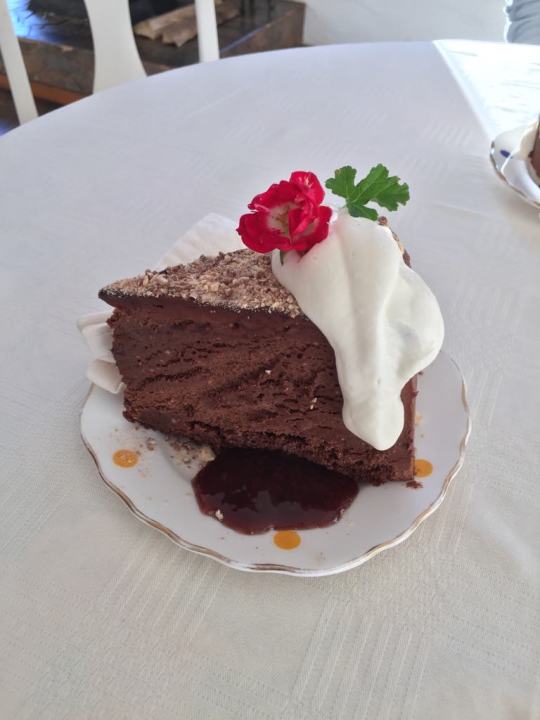

And ply us with food and drink. Fry-ups for breakfast, with home-grown eggs and local Vumba honey and coffee. We contribute a bit with some of the giant avocados we bought on the side of the road in Mozambique + steak we picked up while staying at Island Rock. Matt tries out a new recipe: Chinese 5-spice and orange zest to marinate the steaks, which turns out to be a hit. It also turns out that Mal is interested in drones (for animal census and anti-poaching patrol purposes, which he is involved in locally), and so I'm able to give him a whirl with mine, which looks to be the most gleeful 10 minutes Mal's had in a while!
All in all, Sue and Mal were the kindest and most accommodating hosts to us - total strangers who are just friends of Sue's daughter - and we leave regretfully the next morning, feeling as if we're driving off from a surrogate home.

Leaving the lap of luxury, we head to Nyanga National Park nearby. It is the home of Mutarazi Falls, Africa's second-highest waterfall. It's possible to do a SkyWalk on a bridge spanning the top of the falls, as well as a zipline from one side to the other, but when we discover that these cost USD 40 and USD 70 respectively, we decide that "just a walk along the side of the falls will be really nice, right? Let's just do a walk."
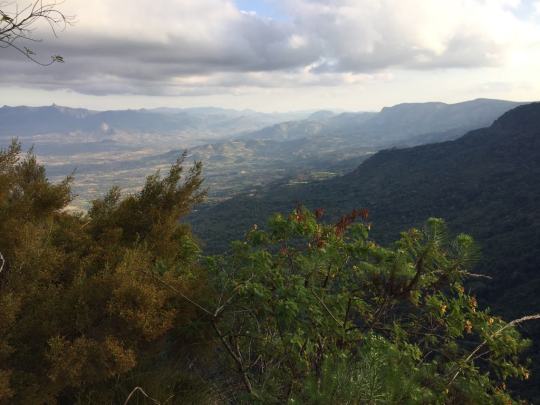
Well, of course, the walk along the side of the falls is REALLY NICE. We are the only people there, and we enjoy a beer on the side of a cliff watching the sunset.



We camp that night at Far n' Wide nearby, and start driving the next morning to Harare: the capital of Zimbabwe.
At this point I should explain that Zimbabwe, politically, is currently at a crossroads. The county's ruler for the last 3 decades, Robert Mugabe ("Ole Bob", other Zimbabweans later tell us), was deposed in a coup last year. The presidency has been taken over by Emmerson Mnangagwa, a member of Mugabe's old guard who is currently serving on a temporary basis. National elections to chose the next permanent president are being held next month: meant to be free and fair and "harmonised" (peaceful), there are 23 candidates running but only 3 of them (including Mnangagwa) are very well known and the incumbent seems sure to win.
The overthrow of Mugabe has brought some changes and optimism to Zimbabwe: for the first time in decades, there's opportunity for improvement and in some respects there has been. Zim used to be infamous, for example, for its police roadblocks - every couple of kilometres along any major road you'd be stopped and your car would be searched for some minor vehicle violation (anything from having your headlights too high, having a fire extinguisher that hasn't been tested recently enough, or having your emergency triangles the wrong width) in order for the police to try and extract a bribe of a few USD. Mal tells us there used to be 19 roadblocks on the road between the Vumba and Harare. Mnangagwa has made an effort to clean up police corruption and boost tourism, though, and we don't encounter a single roadblock on our journey.
But there's still a fair amount of cynicism about the real potential for change, in part owing to Mnangagwa's status as the old guard of Mugabe. How much can the country change when it's still being run by a member of the same group that's run it into the ground over the last several decades? Every Zimbabwean we ask about it (admittedly a small sample size of about 7) says that they're not actually planning on voting in the election.
The most immediate problem facing Zimbabwe is its financial system. Zim's own currency collapsed a decade ago and since 2009 the country's been using US Dollars as its official currency. Zim obviously can't print its own US Dollars, so it's introduced another paper note - bond - which is meant to be a USD subsititute. The government can't print too many of these without drastically devaluing them, though, so there is a third tier of exchange - various forms of electronic money, the most popular of which is EcoCash. Officially, 1 USD in cash equals 1 USD in bond and 1 USD in EcoCash; in reality, there is a massive shortage of cash in Zimbabwe and so cash (in bond but especially in USD) trades on the black market at a premium to EcoCash and its other electronic equivalents. This works out well for us: we initially trade some USD into bond notes with a guy on the street outside a Harare mall and get a rate of 1.25 bond to 1 USD. Later, a friend helps us set up an EcoCash account, which - again through unofficial exchanges with "contacts" that all Zimbabweans with access to real USD have developed - can get us a rate of about 1.56 electronic dollars to every 1 USD in cash. It's ridiculous and complicated, but making the effort to convert our cash to electronic money saves us hundreds of dollars over the course of our time in Zim, making what is (on paper) an extremely expensive country a bit more affordable.
Anyway, once in Harare, we have a blast. We stay at a backpacker's called It's a Small World, where for approximately the same price as roof-tent camping in the parking lot (not too desirable) we stay in a flat-tired camper van parked in the corner.
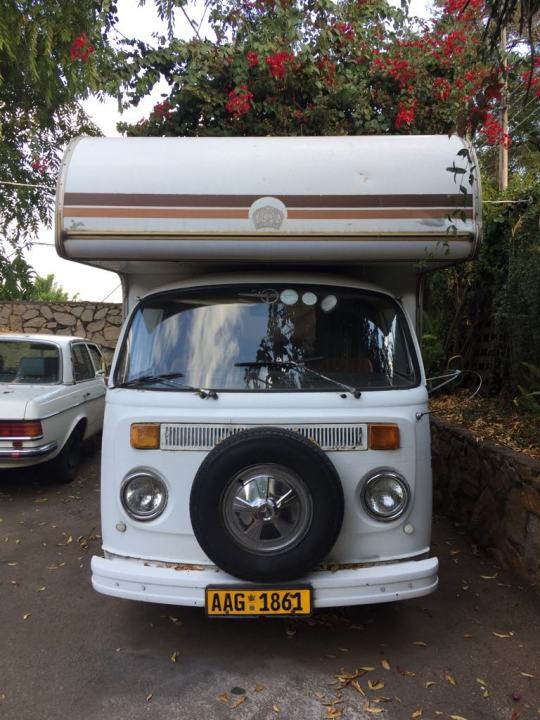
Cozy, our own space, and good WiFi - we loved the van. Even if it was a little tricky to get in and out of...

We take a walking tour of the city with Lynette, a local whom I found on CouchSurfing. She shows us the sites, explains a bit of the city's history, and takes us out for some local Zimbabwean food after the tour.

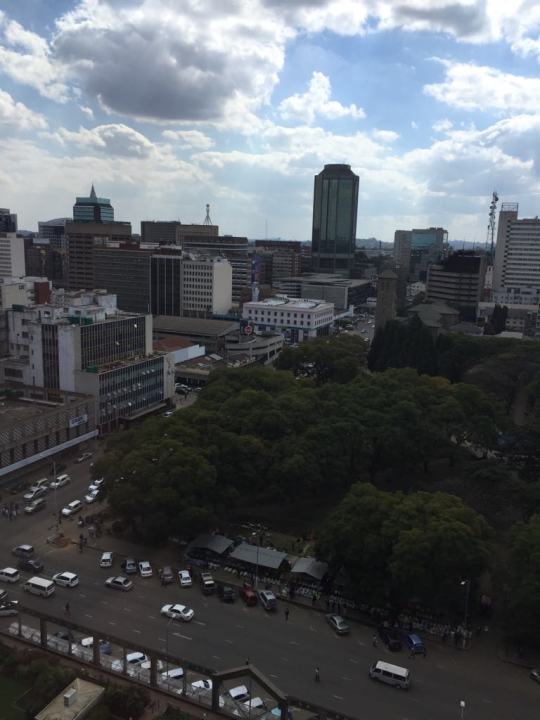


We are even honoured to be joined on the tour by her mom, Mama Lucie - in the several years that Lynette's been running walking tours, this is the first one she's been on!

We attempt to have a few beers and watch a World Cup game at the Jam Jar, a popular restaurant, but the place is hit by a power outage in our first 20 minutes (blackouts are still common across Harare) and so we finish our drinks in the darkness.

Lynette recommends us a few other things to do, including heading to Mareki, which is a BBQ spot popular with locals at a nearby park. Mareki's set up in a dusty parking lot, lined with bottle stores and butcheries on one end and a line of stalls for cooking meat down the middle. You drive in, buy your meat from the butcher, and for a dollar the ladies working the stalls braai it for you for and give you sadza and tomato-onion salad on the side. Delish.
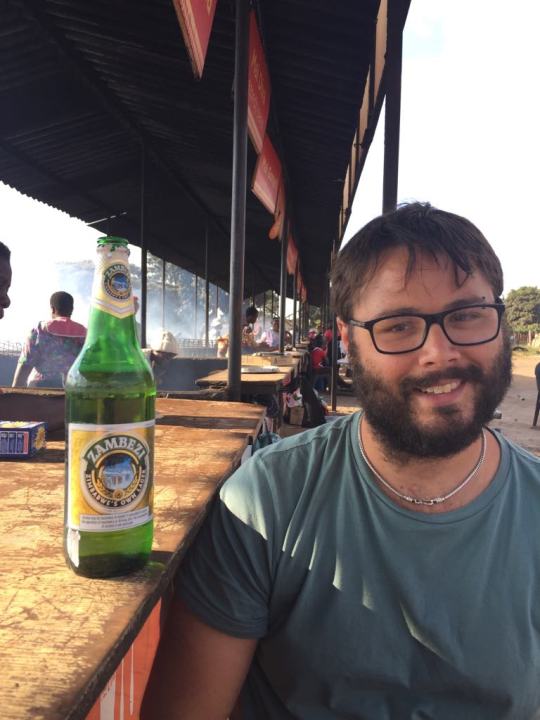
We get our meat braaied by Mai Funghai, a friendly woman who holds my hand and says she'll give me a second salad for free. Sold!

As the only whities wandering around Mareki we attract a fair bit of attention and we end up being chatted to by Gilbert, a friendly Zimbo who clearly wonders what on earth we're doing there. Gilbert introduces us to his friends Simba and Leo, plus Leo's wife Pride and her sister Dorothy. They invite us to come hang out with them and before you know it, we're hanging out in the parking lot with everyone, eating meat and salad off trays set up on the back of Leo's car, drinking Zambezi beers like no one's business into nighttime.

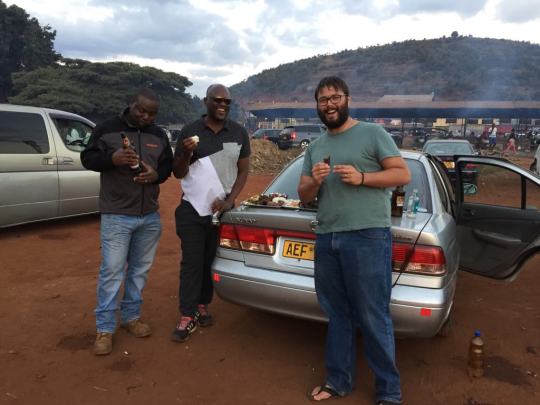

Leo invites us back to his (huge, beautiful) house for drinks (at his in-house bar), where we stay chatting to him and his Zambian friend Jerrick till the early hours of the morning.
We were meant to leave Harare the next day, but our late night has robbed us of the willpower. We end up meeting Leo and Pride for a Nando's lunch before going out to the movies. Leo and Pride spend an hour or so of their time helping us set up our EcoCash account and putting us in touch with their contact to get a good USD/EcoCash exchange rate. When we say goodbye to them, they tell us to call them if we have any problems whatsoever in Zimbabwe, and we are again struck by the friendliness and generosity of the Zimbabweans we've been lucky enough to meet.
Saying goodbye to Harare, we drive northwest. We spend a few hours at Chinhoyi Caves - a system of caverns hovering above the deepest, most crystal-blue pool you've ever seen in your life.
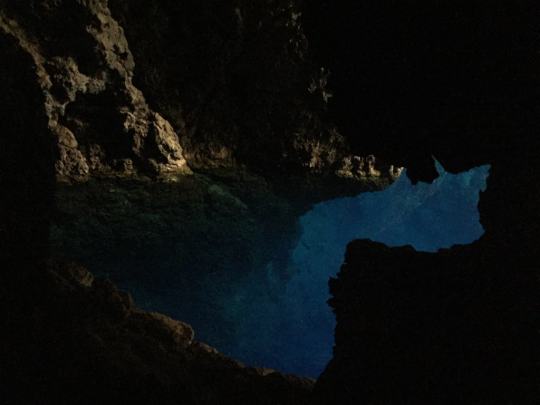
No one knows how deep it is - divers have explored to 80 metres down and been unable to detect the bottom. It's possible to go diving in the pool, which we fully intend to do the next time we're here.
Our subsequent destination is Mana Pools, a national park on the edge of the Zambezi River between Zim and Zambia where we'll spend three nights. Priced at between USD 90 and 115 per night to camp, plus VAT and conservation fees and a vehicle fee, Mana Pools is a huge splurge for us. But all of the Internet says that it is the best most fantastical Disneyworld of national parks, so - bolstered by the money we've earned by converting to EcoCash - we take the plunge.
Inside the park, halfway to our first camp, we get our first flat tire. This is a problem for us as a) due to Stoffel's big tires and modified suspension we need to use our Hi-Lift jack to change it, which we have never done before and has a reputation for being really dangerous, and b) like fools we haven't verified before we left Cape Town that the spare tire fits and isn't flat itself!


We make one attempt to jack up the car, using the center of the back bash plate as our leverage point to lift (essentially, because of the car's suspension) the entire weight of the car onto a three-inch square plate of metal. The jack isn't quite positioned right; it slips out and the car falls. The second attempt works. We can't find the specific allan key needed to get the branded hubcaps off, so we jerry-rig a solution with a Leatherman. We forgot to loosen the wheel nuts before jacking up the car, but with some twisting and turning (very gingerly, because the entire car literally hangs in the balance) we get them off and the spare on.
The spare fits! It's not flat! Thank God....
We drive the last 40 kms and check in at camp. We're spending two nights at Nyamepi on the banks of the Zambezi. Ten minutes after we arrive, enjoying beers while watching the river go by, we are joined by a male elephant who wanders through the camp tearing leaves off trees, takes a dip in the river, and spends the next few hours grazing the grass growing in the river shallows in front of us.




It’s early to tell, but Mana Pools strikes us as a special place.
0 notes
Text
Sand in the Cracks
Leaving the sandy tracks of Ponta d'Ouro, we head north, making our way bit by bit up the Mozambican coast.

Matt expertly inflates our tires for the tarred road.
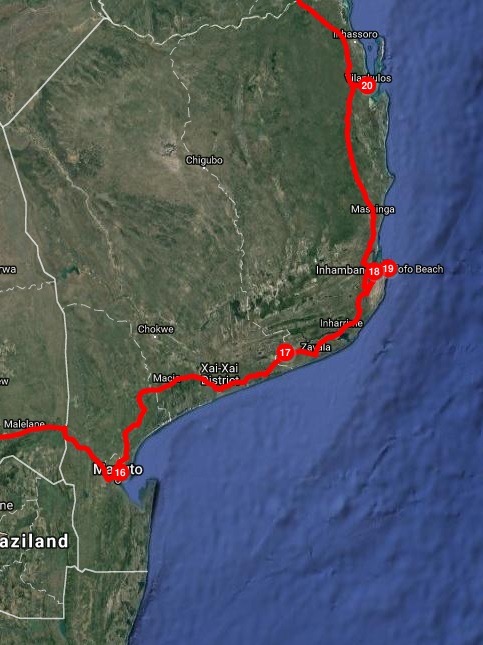
The coast is the treasure of Mozambique: the country has some 3,000 km of land shared with the warm waters of the Indian Ocean, much of it constituting long stretches of empty white beaches. We hop and skip from campsite to campsite:
One night at Jay's Beach Lodge.
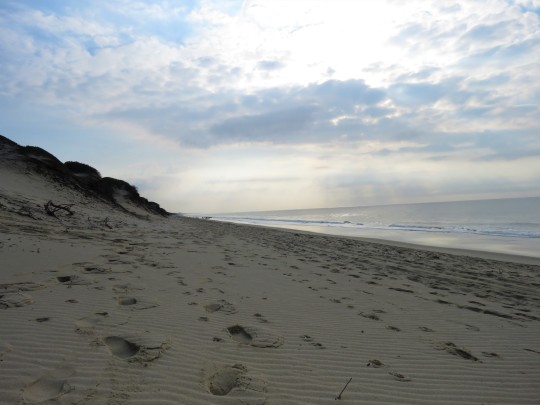
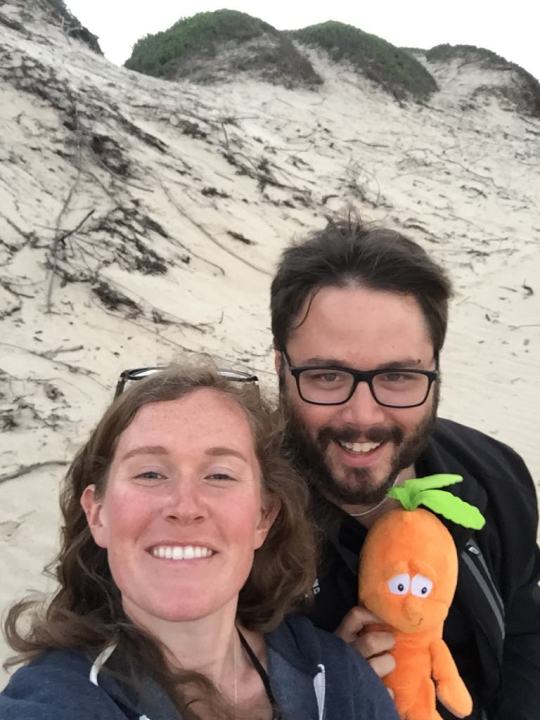
We wake up early and drink coffee from our flask on the beach, where we watch fisherman at work against the sunrise.
vimeo

Two nights in Quissico, a lake province of Mozambique with vast lagoons separated from the sea by a thin strip of land.
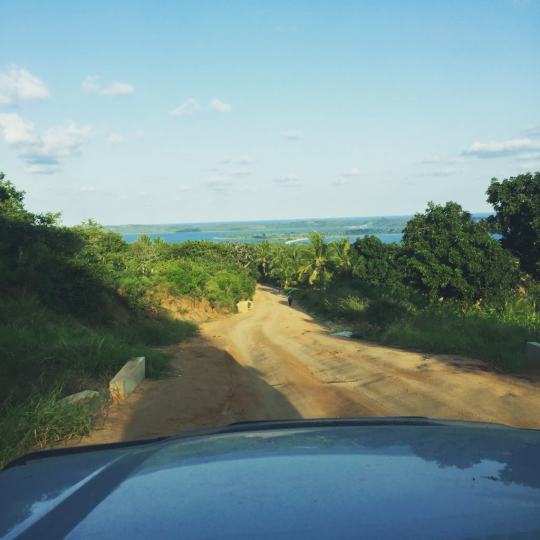
We camp at Lagoa Eco Lodge, a small eco-village run by solar power on the edge of the lake.
vimeo
We spend a lot of time reading and cuddling Lagoa, the village's resident puppy. It's quiet - we are the only visitors at every campsite we stay at.
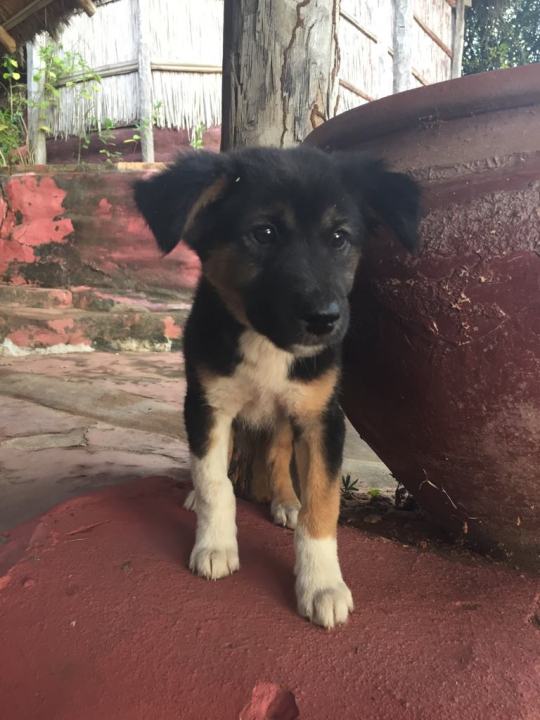

On our drive to Quissico we get our first speeding ticket - and our first veiled bribe request. The fine, a police officer kindly informs Matthew, is MZN 2000 (almost 500 rand) for going 75 km/hr in a 60 km/hr zone. Never mind that the signs marking speed limits are haphazardly placed and generally absent, but that's another story.
Normally you get a receipt showing the amount of the fine and the identity of the officer who gave it to you. However, the cop says, we'll get half off if we pay without getting our receipt (tempting us to save a not insubstantial amount of money, but with the knowledge that the MZN 1000 we do pay is absolutely not going to the Mozambican government and absolutely going into that cop's pocket). After a brief debate, we politely insist on a receipt - only to find out that the official fine is only MZN 1000 after all. He's just taking chances to collect cash without a paper trail.

From Quissico we drive to Tofo. It's a beach and party town: a lot of young international backpackers and students flock to Tofo for surfing, scuba, and marine life. It is famous for its megafauna, being home to manta rays and whale sharks year-round, and scuba divers the world over come here for its colourful reefs and warm waters. The problem for us, though, is that most of Tofo's dive sites are deep - between 25 and 30 metres down, where many of the manta ray cleaning stations (where the rays come to be groomed of particles by hundreds of little fish) are located. As freshly-qualified open water divers we're only qualified to dive to 18 metres.
In for a penny, in for a pound! We take a one-day course qualifying us to dive to 30 metres and complete three more dives in Tofo. That far down, pressure is greater - four times the pressure your body feels on the surface, to be exact. The air in your tank is denser, and accordingly every breath you take depletes your air supply four times faster than it would at the surface, leaving you less time to explore the bottom before you run out of air. Less sunlight trickles down, and a greater spectrum of colour is absorbed by the water around you. Red, orange, and yellow are the first to go, leaving your surroundings various shades of blue, green, and violet.
I'm not sure I can say that marine life gets exponentially more awesome the deeper you go, but by the end of our seventh dive we've had some some remarkable underwater experiences. We've snorkeled with two manta rays - giants as wide as long as we are tall, rising and diving with ripples of their wings in dappled rays of sub-surface light. We've swum through schools of fish 6 metres high, pointing our hands in front of us like spears to part the proverbial seas of them as we approach. We've hung below the surface and watched towers of bubbles from the deep as another group of divers moves below us, to the edge of the reef we've just risen from. Above us, their translucence illuminated against the sunlight at the surface of the water, are hundreds of gently suspended jellyfish.
We also manage to squeeze in a viewing of the first game of the World Cup - Russia v. Saudi Arabia - at one of Tofo’s beach hotels.
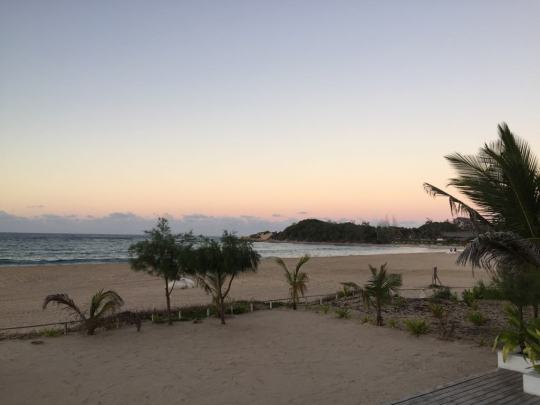
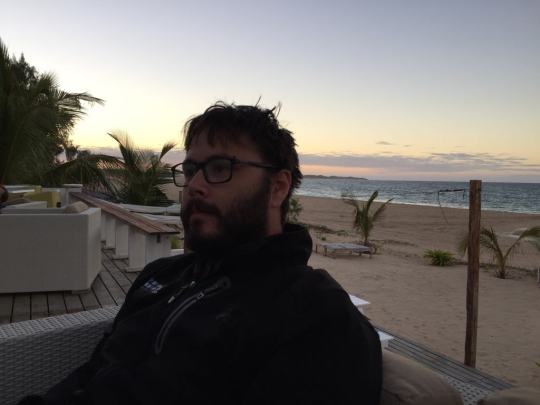
(realising how much he misses Russia)
After two days in Tofo, we realise we are amongst the oldest travellers there. We are roofcamping in the back driveway of a beach hostel filled with young American women who spend a lot of time putting on makeup in the bathroom mirrors and shouting things like "GIRL, you go live your life!" to each other across the dorm hallways.
The revelation that we are old tempts us to stay one more night (it's Friday, party night in Tofo) to go bar-hopping and recapture our youth. But instead, like the ageing fogies we are, we retreat back into the beachy wilderness to spend three nights at Island Rock, an isolated campsite 50 kms south of Inhambane that sits on the coast at the end of a 45-minute drive through deep sand tracks.
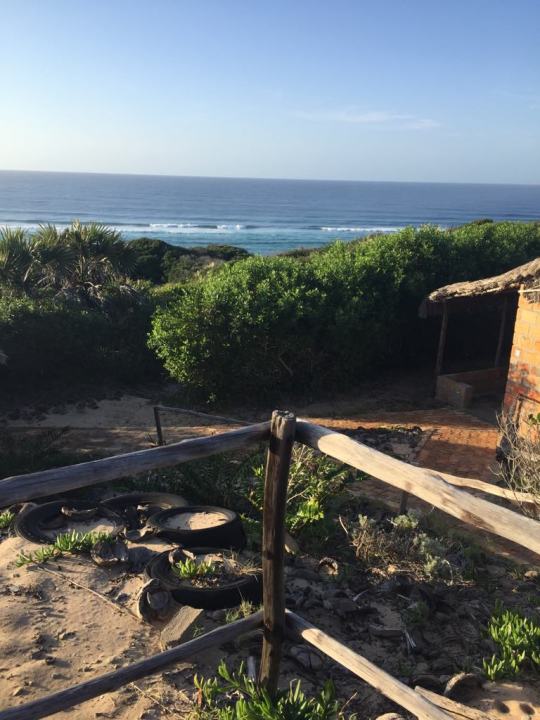
But WELL WORTH the view.
It is quiet. We are the first guests the lodge has had in a week. We spend our days on the empty beach and our nights around the campfire, marveling at the carpet of stars above us.

From Inhambane province we head north again. Average speed, contrary to Google Maps' estimations, hovers around 60 kms an hour and depends entirely on the number of goats/cows/dogs/chickens in the road, times the number of potholes, plus the number of times we stop to buy giant avocados.

The offerings of roadside stands change to reflect local produce as you pass between regions. Between Ponta and Maputo it's all about decorative plants. From Maputo to Bilene there's mostly...chickens in cages, waiting to be killed . From Bilene to Zavala there are stacks upon stacks of oranges. Jangamo to Massinga features mountains of coconuts. Before and after Inhassoro there are piles of rocks (in combination with the abundant potholes, Inhassoro is a grim region). South of Inchope offers pineapples, stacked in neat pyramids along the road. From Inchope to Chimoio, it's bananas.
Two long days of driving and pothole-dodging see us spending our last night in Mozambique in Inhassoro, a small fishing village opposite the island of Bazaruto. From here, we regretfully say goodbye to beach life as we drive inland. Next up: Zimbabwe!
0 notes
Text
Turtle Time
Turns out, we'd been spoiled for border crossings when entering Lesotho. Mozambique was much, MUCH more intense. After leaving the bush house, we headed south to Nelspruit to pick up Matt's passport with US visa contained (huzzah!), then west to the Komatipoort border between SA and Mozambique. As soon as we rolled up towards the South African portion of the border, we'd been marked: a guy standing outside the customs office spotted the Land Cruiser and our two white faces and started waving us towards a parking space - taking ownership of us like we were passengers on his paid tour of the border space. As soon as you leave the car, he's full of instructions - go here, bring this, you'll need that later.
Despite our polite peristence that we didn't need any help, he was impossible to shake off - after leaving South African customs, literally running across the border no-man's land to the Mozambican side to meet us, attempting to steer us toward his preferred third-party insurance provider (a mandatory purchase for border crossing), filling out our forms for us, talking to the customs officials on our behalf. He's soon joined by other guys, following closely, offering you SIM cards and emergency triangles and vehicle stickers, who shuffle nearer and nearer no matter how many times you say you're not interested. As the female of our pair, I am of no consequence - everyone focuses on Matt, the man and clearly the decision-maker of our group. When all our papers are in order, we escape back into the car and leave our small crowd of new friends with Matt rolling up the window and still muttering "no....no thanks..." in the faces of four or five disappointed guys as we drive off...
....only to spend 20 minutes waiting at a construction stop-go no more than 50 metres from the border.
We spend the night in Maputo, the country's capital, at a backpacker's called Fatima's Place in the middle of the city. Given the options to camp in our roof tent in their driveway for MT 700 per person or to get a bed in the dormitory for MT 800, we say to hell with camping. They've even got a bar and free wi-fi!
We go for a nighttime stroll around the city, hoping to make it to the beach (our backpacker's is only three blocks away), but we take a wrong turn and wander aimlessly for a while instead. Maputo is a weird mix of Eurasia and Africa: a former Portuguese colony, the country's official language is still Portuguese. But there's obviously been a lot of Communist influence: we spot a few Soviet-style boxy high-rise apartment blocks, and our hostel sits on the corner of Mao Zedong and Lenin Avenues. Significant amounts of money have obviously been invested in parts of the city: there are some beautiful mansions facing the coast, and the spacious ground floor of one building boasts a plaque commemorating its dedication as a restaurant in 2013 by the mayor of Maputo. It's tropical(ish) - there are palm trees and sand everywhere. But the sidewalks are mangled and broken; the mansion by the sea has never been finished and sits abandoned behind a construction curtain; the restaurant has closed down since 2013 and is empty.

For example: a mansion on the coast, overlooking the ocean on one side and...an abandoned garage on the other.
Maputo feels like the kind of city whose magic opens up to you only after you stay for a while. But we've got a craving for the beach, so we head out the next day: south to Ponta d'Ouro, a tiny village in the far south eastern corner of the country. Asia's influence in Mozambique becomes evident - the road to Ponta used to be a sandy track, impossible to navigate when wet, making the 300-km journey take 5-6 hours to complete. All that has changed with the entrance of the Chinese, who have built a tarred road system the entire distance between the two cities that's so new our GPS doesn't recognize it.
We fly through the journey in just 2.5 hours and arrive in the rain to our new home for the next week - Gala Gala Eco Lodge, a deceptively large quasi-village with what must be 50 campsites and a handful of cabanas. After checking in, we head over to the beach to check out our REAL priority for the week: SCUBA DIVING!

That's right. This week we are getting PADI certified. An open water course, which qualifies you to dive up to 18 metres, takes around 4 days to complete. It includes a theory section (lots of reading and quizzes), a pool day (attempting to control your buoyancy in water that's barely deep enough to dive in), and 4 sea dives, each of which test a variety of skills alongside your exploration of the reef of the day. These include recovering your regulator in case you somehow lose grip on your only air source...the tube that goes in your mouth; taking your mask off at the bottom of the ocean, putting it back on, and clearing it of seawater by blowing out your nose in case you have a death wish, or otherwise get your kicks out of doing stupid and scary things, etc.

Thankfully the skills get less scary the more times you practice, and after 5-10 minutes of skills at the start of each dive you get the rest of the time to explore the reef. We don't have an underwater camera so this part will be left to your imagination, but DIVING IS AWESOME. We've seen pods of dolphins surfing massive waves amidst rainbows in the sea spray on our way out to the dive site, a stingray with a 5-foot wingspan swimming in and out of a cavern, a green turtle, a pufferfish chilling under an overhang, a (giant) potato bass guarding his reef, an octopus hiding in a hole, a few giant moray eels, and many more exoticities. Despite all my anxieties to the contrary, we have not once been attacked by a sea creature from below.
We spend five days completing our course at a leisurely pace with Blue, our tremendously patient and talented scuba instructor, her boyfriend Tibo - also an instructor - and Alarda - another South African from Mpumalanga who's the only other student this week. Our lessons are interspersed with naps, lounges on the beach, and consuming vast quantities of peri-peri prawns.
vimeo
Also beaching. Lots of beaching.

We are one of approximately 5 tourists in town (it's low season), and so we are persistently followed around by guys selling things - from bracelets to bowls to backpacks to shoes. One man speaks to us for 20 minutes in the beach parking lot, showing off his handmade leather wares. When it becomes apparent that we've got tight wallets, he pulls out his trump card - "want to buy some weed? Good price, 100 rand a bag."

We did not support our local drug cartel, but Matt did buy a pair of board shorts branded with the logo of Deutsche M, one of the Mozambican beers.
Alarda, Blue, Tibo and us all become fast friends and by the last night after our final dive, we're all having sunset drinks together on our favourite beach before going out to Lulu's (a local restaurant frequented by ACTUAL locals, a rare and difficult find) for peri-peri chicken.
Blue forgets to take our photos for our PADI cards until we're saying our goodbyes, so she does it quickly on her phone. Our diving card photos will forever show us in the dark, in a parking lot in Ponta after a few beers, happier than ever that we're here.
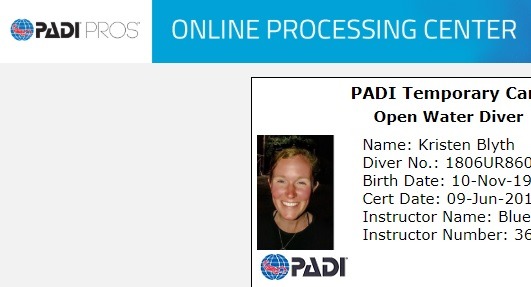

2 notes
·
View notes
Text
Long necks and Funny faces
Good news first: Matt’s been accepted for his US visaaaaaa!!!!

Despite some minor panic standing in line outside the consulate when Matt realised he’d forgotten to print a minor document, the final interview was actually very straightforward: confirmation of a few facts, a quick flip through Matt’s pile of evidence that we are in fact married, and BOOM! 45 minutes later, they were asking where to mail Matt’s passport containing his spanking new visa in 5-7 working days.
Joined the same day in Joburg by our friends Ross and Will, we celebrated by 1) dinnering with our friend Tara:

and 2) heading out of town - leaving the city in our rearview while we headed to Umvanghazi, Matt’s family’s house in the bush near Hoedspruit, in northeastern South Africa.

When you’re carrying your life possessions in the back of your car, adding two more people’s stuff can really get tight.
We’ve been hanging around Umvanghazi the last 11 days - doing some heavy-duty relaxing while...not really doing much of anything.
There’s been some beach bats:

Nature photography-ing:




Suntanning:
vimeo
Enjoying of sunsets:



vimeo
And braaing round the fire:

We went to visit Jessica the Hippo, a wild hippopotamus who has made herself part of a South African family near Hoedspruit. Her story is actually incredible - she was born prematurely and washed away from her mother during a flood, but discovered - umbilical cord still attached - by a game ranger. He and his wife have hand-raised her; she sleeps in the house with them at night, and during the day goes out to the Blyde River to hang with her hippo friends. She’s wild but tame at the same time, and the family runs a few ‘tours’ a day where you get to meet her, learn her story, give her a couple bites of food and kisses on her face while she drinks a bottle of rooibos tea.

Will, of course, was unable to follow instructions about how to feed Jessica, and ended up rudely splattering corn all over her face:

Luckily Ross caught the moment so that we can make fun of him forever.
We spent a few days camping in Kruger National Park and got some (in my humble opinion) not-too-shabby wildlife shots:






Notable sightings include: Ross witnessing his first leopard (hidden napping in a bush 100 meters from the road, a very typical leopard sighting) and a three-legged hyena ravaging a hippo carcass.


Bookended by many nights of hanging in the boma while coming up with ever-more-outrageous rounds of “would you rather”, it’s been a stellar time.






Thanks Ross (who sometimes reads this blog) and Will (who never bothers) for the photos and the good times - you’ve really made our trip special so far.
Now that the boyz have departed, our next stop: Mozambique.
0 notes
Text
Taking the High Road
On the morning of day 4, we left Semonkong as early as we were willing to face the cold. The extra day spent without driving taught us a valuable lesson: something was draining our primary car battery. Fortunately, we could jumpstart using our auxiliary battery. The camp manager, a seasoned Namibian overlander named Rudy, recommended we visit Matatiele in South Africa to get it checked out. After all, he made it very clear that he wants to buy Stoffel, our beloved Land Cruiser, after our trip.
“It could be a short, which is dangerous,” he said, “and you won’t find a good auto-electrician in Lesotho.”
So it was back across the border into South Africa for us, another winding mountain pass out through Qacha’s Nek border post and onto the straight roads and fast speeds of SA. We made it to Matatiele in time for lunch and auto-electrical fault finding. Unfortunately, it being 3 pm on a Friday afternoon, Matatiele’s finest auto-electrician didn’t have time to track down what’s draining our battery, but confirms that it’s not a short, nor dangerous. He recommends we disconnect the primary at night and get it checked out when we reach Johannesburg or Hoedspruit when we have more time. We drown our disappointment with take-out biryani and bunny chow.
Never to be dissuaded, Stoffel and us continue on our way to that infamously treacherous and glorious 4x4 route: Sani Pass, into Lesotho. We stop for the night at the foot of the Drakensberg, camping at Sani Pass Lodge. As we sit around a potjie pot of steadily simmering Thai Green Curry, we are visited by a pride of local half-wild cats and neighbouring French backpackers.
Day 5 found us tackling one of the highlights of our trip thus far. Stoffel, in the midst of a convoy of his younger and smaller peers, began the slow climb up Sani Pass.



The road was rough, the view was breathtaking and the experience was unparalleled. Sharp corners, crumbling rocks and narrow roads were a few of our challenges on the way up.


We reached the top with a new appreciation for the abilities of a Land Cruiser in low range and a fond camaraderie amongst our fellow drivers. We celebrated our success with a few beers and mediocre pasta at the highest pub in Africa.


Our mascot, Tuk, also got a photoshoot.

After a longer than expected stay at the pub, we resumed our journey, heading through Northern Lesotho towards Liphofung Caves.
The route took us through the snowy heights of Lesotho, around tight mountain passes with suicidal drivers and past AfriSki, at this time a rather underwhelming African ski resort.

The road was long and winding, including the hairy Moteng Pass, but eventually we arrived at the caves after nightfall. Only then did we discover that the caves, cultural centre and its associated accommodation had all closed down. We were informed very insistently by a rather stern older lady walking past that it had closed due to lack of water and we would have to look elsewhere. So we did, utilising our GPS to find other accommodation about twenty minutes away, Moteng Lodge, only to find it derelict and reoccupied by a shabeen (an informal bar) with some quite confused patrons. “No, you cannot stay here. You cannot.” they said.
As the hour grew late, we had to retrace our steps over Moteng Pass, Kristen facing oncoming trucks, many potholes, and stray sheep in the darkness. Eventually we found our way to New Oxbow Lodge. Despite its name and size, it was dated and empty. It had no camping, so we rented our first (overpriced) room of the trip. As Capetonians in Lesotho, we took full advantage with two steaming hot baths.
The morning saw us leaving Lesotho for the last time, through Caledonspoort, a far larger border post than we had been through previously. One of the officials was aghast to hear that we had entered the country without being treated to the official tourism briefing. She shepherded us into her office and proceeded to inundate us with pamphlets and information about all the great attractions of her mountain kingdom. All of it was useful stuff, but stuff that would be more useful if we weren’t exiting the country.
Now back in Mzansi, we made our way to the uniquely picturesque Golden Gate National Park. We visited a vultureless vulture hide, before picnicing and giving the old drone a bit of a fly.
vimeo
While cruising around aimlessly, we stumbled upon a Basotho living museum and decided to go for a guided tour. The two of us were marched around a faux Basotho village, meeting the chief and queen, drinking traditional beer and eating traditional food, and looking at Basotho clothing ranging from the 1600s through to now.



What was particularly interesting was the Basotho family that was on the tour with us, and their kids, with strong American accents, who were rediscovering their heritage.
After some more aimless cruising, droning over a water-crossing, and spotting a shifty jackal, we made our way to Bokspoort: a nearby cowboy ranch.
vimeo

When our evening camping routine was interrupted by a sudden downpour and an even more alarming lack of booze, we took refuge in the Bokpoort bar to share a drink or three with the owner’s wife. The decor of the bar confirmed our suspicions that the owner might be an avid hunter.

Day 6 will see us driving to Johannesburg for Matthew’s USA visa interview and meeting up with our Johannesburger friends, and picking up Ross and Will for the next leg of our trip: Umvanghazi, in Mpumalanga.
0 notes
Text
To the Mountain Kingdom
The first stop on our Tour of Africa is Lesotho: a tiny, mountainous country-island surrounded on all sides by South Africa. It rests amongst the clouds - Lesotho is the only country in the world that lies entirely above 1,000 m in elevation. We plan to enter Lesotho through the Telle Bridge border crossing in the south, making our way 183 kms north and then west to reach the city of Semonkong.
We dawdle along the way, stopping for a little drone and photo opp at the Orange River near the border.





vimeo
Land border crossings have two parts: a gate manned by officials of the country you're leaving, followed by another gate for the one you're entering. Having done a lot of research into border crossings in Africa, I was getting a little anxious as we approached the border post - not that Telle Bridge is a particularly busy or difficult crossing, but if they decide to, officials can give you a lot of hassle over declaring your belongings and searching the car.

Both sides were actually a quiet breeze: despite the South African officer being surprised that an American was accompanied by a South African at the first gate, and us failing the language test set to us by the Mosotho officer at the second ("where are you going?" she asked in Sotho when we arrived at the counter, met by blank stares by us), we were waved through without so much as ONE question about whether we were carrying any illegal items. Fine by us..
Along the way to Semonkong, we stopped by the town of Quthing, 20 kms from Telle Bridge, where there are original, preserved dinosaur footprints. When we arrived at the building where the footprints are housed, though, the door was locked and no one was around to let us in! We loitered for a while, ate a sandwich in the parking lot, then decided to ask a worker sitting at the side of the lot if he knew what was up. He spoke no English, but Matty did a very accurate impression of a dinosaur stomping around and he got the gist of what we were asking (no joke).

Once he understood, he became very dedicated to helping us - knocking at various doors of the building, asking the neighbors if they'd seen the lady who runs the place, going to a nearby store to call the number posted on the door (no answer). At this point, we decided to call off the hunt. We bought our new friend a Coke for his troubles and set off to Semonkong.
We did, however, get a photo of the outside of the building - which is just as good, right?

It's incredible how dramatically the landscape changes as soon as you enter Lesotho. The country is dominated by high, rolling mountain ranges with windy, twisty roads up and down past tiny villages - each filled with small children that smile and wave enthusiastically at the whiteys driving past.



It quickly became apparent, though, that we were not going to make the drive in the 3.5 hours estimated by the GPS. We've since been told (several times) that "in Lesotho you drive by hours, not kilometres" - the roads we were driving weren't in bad condition, but were so winding that it is impossible to get up to more than 50 kms/hour. We resigned ourselves to arriving at our campsite after dark and stopped for one more sunset photo opp.


Our accommodation for the next two nights is Semonkong Lodge - a gorgeous, chilly little place tucked between the side of a mountain and a frosty, clear stream that lulls you to sleep at night. Small lanterns dot the mountainside, marking the lodge's villas (although we're camping), and there's no light pollution: when you look up, the whole Milky Way stretches cold and crystal above you.
I'm using a lot of *cold* adjectives because we sincerely underestimated HOW COLD we would be at night in Semonkong. It reached 0 degrees Celcius in the evenings - by our last night there, we were putting on every item of clothing we had: I was wearing a T-shirt, a thermal longsleeve shirt, a sweatshirt, a jumper, a leather jacket, stockings, sweatpants, two pairs of socks, slippers, a hat, a hood, and a scarf to cover my nose and mouth...all inside my sleeping bag and under another blanket.

Matt donned our pair of oven mitts as makeshift gloves. He has given them 5 stars for effectiveness and I won't be surprised if he starts wearing them on the streets of New York at winter.

Two activities we did at Semonkong: first, a hike to the Maletsunyane Falls.

vimeo
The Basotho are extremely friendly towards tourists (apart from 2 other guests at the lodge + the lodge's manager, we are the only white people we see in Lesotho), with 90% of passers-by giving us a wave and a greeting.
We also came across some very exciteable children, whose only English consisted of "hello! how are you! Bye-bye!" (repeated many many times).

In the evening: a donkey pub crawl. It was exactly what it sounds like: we rode donkeys around to a few public bars in Semonkong, accompanied by two guides who are from the region.


The bars are mostly rooms empty of furniture, blasting music while guys wait for their turns at the pool table.

One of our guides, Emmanuel (a young guy, maybe 25), tells us about how life in Lesotho has changed as the country modernises. Lesotho is famous for its blankets; traditionally, Basotho would only wear blankets in the colours of their district. Semonkong is in the Maseru district, whose colours are black and blue; you could tell where anyone was from by the shades of their blanket. But now, he said, people can buy any blankets of any colour - they don't wear them to represent their community anymore.
The community has changed in other ways too. Emmanuel told us that you used to pay an obligatory 25 cows for lobola (bride price) to get married. He estimates the average cow is worth about 8,000 rand, which adds up to an astonishingly high sum for any young working adult wanting to start a life with someone. Now, he says, lobola is a little easier - most men he knows would have to pay only what they can - 6 or 8 cows, or sheep or goats.
The donkey ride back to the lodge is quiet. Full of Maluti beer, ears ringing from bar music, we toddle off to our icy tent for a chilly night's sleep. Tomorrow, we’re off to Sani Pass.
vimeo
1 note
·
View note
Text
And we're off! ....to Smithfield
All I remember from our last few days in Cape Town was a frantic cycle: packing up our old flat in Woodstock. Selling/moving/donating all the odds and ends that you accumulate over the years: where is the top to this Tupperware? Why do we have two ironing boards? Should we keep these Christmas ornaments? Sorting items into long-term storage and things to take with us on the trip. Further culling the pile of stuff to take on the trip because you've inevitably packed too many pairs of comfy pants and they won't fit in the small box you've allotted yourself for personal items. Going shopping: Cape Union Mart for binoculars and GPS; Midas for cable ties, power steering fluid and spare fuses; H&M for extra T-shirts and pantoffels; to the pharmacy for antiseptic, water purification tablets, and bandages; back to Midas because you've forgotten to get a tire repair kit the first time around; back to H&M becuase you've forgotten to get a cheap pair of shower sandals and you also need some extra socks. Saying goodbye to friends (and friends’ babies) in the midst of it all (hi Finley!)

We've successfully rehomed our own three fur babies - with Matt's aunt in Somerset West, who has a huge garden and two other bunnies (Leo and Teddy). After a short bonding period all five buns are now roaming happily amongst the leaves and aloe plants, with our three probably forgetting that they ever had a home in Woodstock at all (sob!)

Devastated as we are to leave them, we're happy that they're now living in what amounts to bunny paradise with a couple of new friends.
We took a 4x4 driving course: a full-day class with a theory discussion in the morning and practical mountain driving in the afternoon. It was incredibly useful; we can now proudly say we know on what terrain to use high range and low range, and what it is that a diff lock really does....
The practical part of the day was midly terrifying. No photos were taken as I was too focused on not killing us, but picture this if you will: you're faced with a 60 degree mountainous hill. There's a small rock in the middle of the track, and deep holes to the left and right where rains have washed away the soil. You get out of the car and walk the route, planning your lines: keep left, putting your right tire over the flat part of the rock and your left one at the edge of the road till you hit the peak of the rock, then edge right to avoid the massive hole on the top left, but you have to put your right tire on this one ridge otherwise you'll bottom out your axle on another rock jutting out. You put the car in first gear, low range, turn on the central and rear diff locks, and ease the car over the obstacles. Don't clutch, don't lose momentum, but don't rev, and keep a slow and steady pace till you're over the top. Then, give yourself a pat on the back for not killing anyone or wrecking your car (yet).


I don't think we'll be seeking out extreme 4x4 situations per se, but if we're taking this beast of a car to Kenya we may as well find some unpaved roads to use it on.
The sturdy steed escorting us on the journey, by the way, is a 1999 Toyota Land Cruiser 105 equipped with a rooftop tent, a snorkel, a drawer storage system, modified suspension and tires, long range tank, and dual batteries.

We have affectionately named it Stoffel, after THIS honey badger. Persistent, resilient, and tough, ready to escape any situation: we've put faith in Stoffel to get us through whatever we put in front of it.

Day 1: we set off from Cape Town at 530 am.


Ahead of us is a 12-hour drive to get us as close to the border of Lesotho as possible. We briefly consider the charming town of Zastron as our destination (it boasts as tourist attractions both a vulture colony and a hole called the Eye of Zastron) but we end up settling on Smithfield, a slightly closer town about 2 hours from the border.
The drive thus far is uneventful: long stretches of empty karoo that you forget are out there when you lived in a city as packed for space as Cape Town.


We arrive just at sunset at our home for the night: Rufpatch, a little campsite on the edge of town. Setting up camp for the first time is always a struggle - we discover amongst other things that the camping table we bought at Game for all of R800 is partly broken! But the rooftent is working fine and so after a few burgers on the braai and a bottle of wine around the campfire, we call an end to Day 1.
2 notes
·
View notes
Text
Ninjas of admin
“Why have we not posted since December,” you ask. “Why have you kept us on the edge of our seats this whole time,” you complain (sarcastically). “We want UPdates,” you demand.
The last few months have flown by. Not sure why, since they have 99 percent consisted of a) working long hours at the office, and b) spending nights in at home planning.
I won’t bore you with the details, but all the things we’ve been planning for are starting to fly by themselves.
Exhibit A: Last Saturday, we got married (again - sort of).

#bridesmaids

They are all actually gorgeous, I swear

#groomsmen

They are all handsome, I don’t need to convince you

Ceremony area: on the edge of the Hermanus Lagoon

We got VERY lucky with weather

We have amazing and beautiful and talented friends who helped us with decorations (ahem @sagegoodwinillustrations)


vimeo
The drone made an appearance, albeit a very unpolished one

Matt seriously considering the implications of what he’s just done

We trekked across the vlei to get the perfect sunset shot

We had spectacular food (ostrich medallions, get in my tummy)

We teared up during speeches
vimeo
We did a little dance

By the end we got trashy

Except for Matt, who keeps it classy.

Juuuuuuust kidding.
From a completely unbiased perspective, it was the best wedding ever, and that’s all I’ll say about that.
Now that international family and friends are trickling back out of town, it’s on to the next big thing.
I present to you Exhibit B: Trip Planning While Also Moving out of our Flat in Cape Town, Saying Goodbye to Everyone and Everything We Love in SA, and Preparing to Hop the Pond to America.
I’m not convinced that coinciding a wedding with a 3-month road trip and an international move was the smartest move we’ve made, but anyway. Please enjoy this short sample of our 4-page list of supplies:

In the next two weeks we’re going to be doing a lot of:
-Shopping
-Packing
-Selling stuff on Gumtree
-Crying as we say a (temporary, fingers crossed) goodbye to our suns and stars, our 3 bunnies
-Feeling conflicted about leaving
-Feeling excited about going
And repeat.
We leave Cape Town on May 15.
1 note
·
View note
Photo

To the world at large.
We are about to embark on a 3-month road-trip from our home in Cape Town, South Africa to Dar Es Salaam,Tanzania. This tumblr will document our story as it happens, from preparations to burst tyres and border-crossing to whatever hidden treasures we come across.
We are Matthew and Kristen Stone: Matthew, a South African born-and-raised business consultant cum writer, and Kristen, the American, but travelled risk management consultant pictured above in Kruger Park.
At present, we are in the planning stage of our trip, which will depart Cape Town in May 2018. Our mapped route will take us through South Africa, Lesotho, Swaziland, Mozambique, Zimbabwe, Zambia, Malawi, Tanzania, Uganda and Kenya. Along the way, we will snorkel, spelunk, camp and raft, as well as face all sorts of unexpected twists and turns.
Before we can do that, however, we need transport. The next step in our preparation is securing a suitable 4x4 and kitting it out with all the required gear and equipment needed to survive 3 months of African wilderness. We have just such a Land Cruiser in mind...
Details will follow shortly.
2 notes
·
View notes